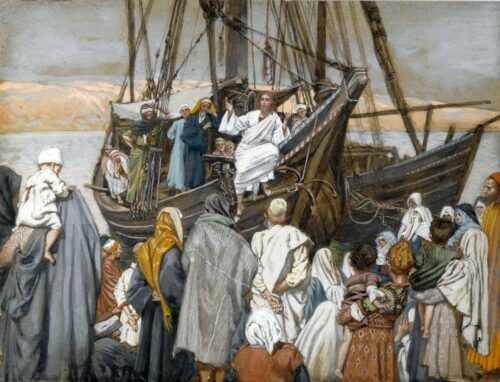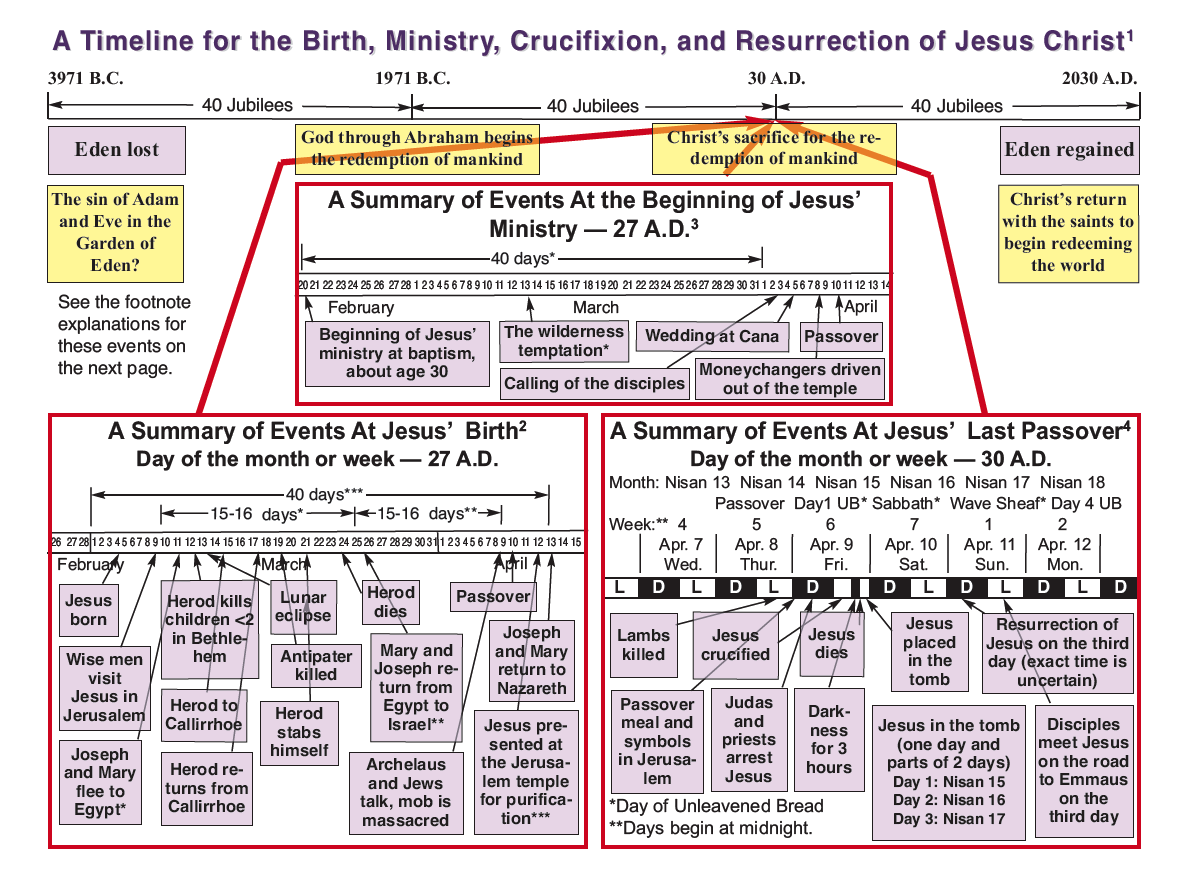Explanatory Notes for “A Timeline for the Birth, Ministry, Crucifixion, and Resurrection of Jesus Christ”
The times presented in this scenario have been determined through considerable research over the past decades. It cannot be absolutely ascertained what are the exact times for all events related to Christ’s life in the flesh here on earth — only God knows all of the details — but it is the best analysis I have been able to determine as of December, 2021. Paul W. Syltie, Ph.D.
1. The 6,000-year plan of this age.As the week has seven days, with each day as 1,000 years in the Eternal’s eyes (II Peter 3:8; Psalm 90:4), so the plan of God for mankind in this eon is 7×1,000 or7,000 years. It is rational to divide the first 6,000 years into three segments of 2,000 years each —plus the final millennial reign of Christ in the Kingdom — since we have good knowledge of the dates for two primary personalities who are critical for all of history: Abraham and Jesus Christ. Since a Jubilee cycle is 50 years, then there are 40 Jubilee cycles for each 2,000 years, 40 representing a period of “probation, trial, and chastisement” (E.W. Bullinger, Number in Scripture, Kregel Publications, Grand Rapids, Michigan, 1894, pages 266-267).
Archbishop Ussher’s chronology of the Bible places the creation of Adam in 4004 B.C. (JamesUssher, The Annals of the World, E. Tyler, London, 1658), and the birth of Abraham at 1996 B.C. (Seealso E.W. Bullinger, The Companion Bible, Appendix 50, Zondervan Bible Publishers, Grand Rapids,Michigan, page 51.) The significance of Abraham’s (Abram’s) life cannot be underscored enough,since he is the one the Father chose to begin the process of reconciliation of sinful man to Himself,which resulted in the many promises to redeem the nations of the earth (Genesis 12:1-3; 17:1-9) aswell as give rise to the seed of the Second Adam, Jesus Christ, Abraham’s descendant through the line of Judah, who came to redeem the sins of the world. Other sources (en.wikipedia.org, Abraham)contend that Abraham was born in 2150 B.C., so there is some question as to the exact date of his birth. What is not in question is the fact that he was 50 years old when he received his “first call” in Urof the Chaldees (Acts 7:1-4 Genesis 11:31), and 75 when he received his “second call” (Genesis12:1-5). According to Ussher, the first call was in 1946 B.C., and the second call in 1921 B.C. Considering the strong likelihood that the 2,000-year points in time are highly important in dating the major events along the timeline, we can consider the beginning of Christ’s ministry as being one point, and Abraham’s move to Canaan to as being another point. To date these points, there is some question as to the veracity of dating Abraham’s birth. I believe that Abraham was born in 2046 B.C. Seventy-five years later brings us to 1971 B.C., when Abraham arrived in the land of Canaan with his entourage. This would place the major event in Genesis 3, of the confrontation between Satan, Adam, and Eve, and the sin they committed, 2,000 years earlier to 3971 B.C.
The completion of the ministry of Jesus would be in 30 A.D., 2,000 years after Abraham’s calling to Canaan. There is considerable evidence that this date is accurate, as we learn from the evidence of Christ’s birth having been in 4 B.C. This matter will be discussed in section 2.
Moving forward 2,000 years from the completion of Christ’s ministry in 30 A.D. brings us to the year 2030 A.D. Might we not expect the return of Christ at some time during this year?
2. A Summary of Events At Jesus’ Birth — 27 A.D. A goodly portion of this summary has been borrowed from the paper, “Christmas — a Holiday Rooted in Paganism That Christians Must Avoid” (PaulSyltie, available at www.churchesathome.org). In this paper it is shown that Jesus was not born on December 24 or 25, the dates for the pagan Roman Saturnalia and Brumalia, a celebration of theMithraic gods and goddesses of licentiousness and license.This celebration hearkens back to ancientBabylon, and the great anti-God leader of Babylon, Nimrod (Genesis 10:8-12), and his mother-wifeSemiramis. He wished to elevate himself above the Creator, and have all peoples bow down to him rather than worship the one true God. Sources besides Scripture used for this paper are several, including Flavius Josephus (The Antiquities of the Jews, Kregel Publications, Grand Rapids, Michigan,1960), Alexander Hislop (The Two Babylons, Loizeaux Brother, Neptune, New Jersey, 1916), andPhilip Schaff (The New Schaff-Herzog Encyclopedia of Religious Knowledge, Baker Book House,Grand Rapids, Michigan, 1952). Some subject headings include the following:
When we Jesus really born?
The death of Herod the Great
Christ’s birth in relation to Herod’s death
The courses of Abijah (Each course was performed twice a year, in the fall and in the spring.)
Christ begins His ministry at age 30 (Daniel 9:26-27 does not refer to Christ destroying the city and the sanctuary, but the “people of the prince”; he will bring an end to sacrifice and offering in the middle of the week (3.5 days, or 3.5 years if each day represents a year: Ezekiel 4:6;Numbers 14:34), not Jesus Christ. Thus, there is no basis for assuming the beginning of Christ’s ministry in the fall rather than the spring to reach a 3.5-year period.
More clues to the birth date of Christ
The true origin and meaning of Christmas
Further insights into Nimrod
Cannibalism and the fire god
Nimrod identified with Satan
The icons of Christmas
As the timeline shows, Jesus was born around late February or early March of 4 B.C., shortly before a lunar eclipse, which Josephus mentions in The Antiquities of the Jews. Even though this was not a complete eclipse, it is the one that fits the historical information we know regarding when Herod died. Only the March 13 eclipse fits with birth of Christ in context with his 3-year ministry beginning at about age 30 in 27 A.D. Here are the lunar eclipses that occurred before and after 4 B.C. (David Sielaff, Astronomy and the death of King Herod, Associates for Scriptural Knowledge (ASK), www.askelm.com).
5 B.C.March 23. Total eclipse. Central at 8:30 pm (elapsed time between eclipse and Passover: twenty-nine days).
5 B.C.September 15. Total eclipse. Central at 10:30 pm (elapsed time between eclipse and Passover: seven months).
4 B.C.March 13. Partial eclipse. Central at 2:20 am (elapsed time between eclipse and Passover: twenty-nine days
3 B.C.No eclipses
2 B.C.No eclipses
1 B.C.January 10. Total eclipse. Central at 1:00 am (elapsed time between eclipse and Passover: twelve and a half weeks ).
3. A Summary of Events At the Beginning of Jesus’ Ministry — 27 A.D.This timeline is easily gleaned from John 1 and 2.
Baptism of Jesus by John the Baptist (John 1:29-34)
Jesus was immediately led by the spirit into the wilderness for a 40-day temptation (Matthew 4:1-2; Mark 1:12-13; Luke 4:1-2).
Calling of the disciples (John 1:35-51; Matthew 4:18-22)
Wedding in Cana where Jesus turned the water to wine (John 2:1-10)
After the wedding in Cana, Jesus, His mother, His brothers, and His disciples went to Capernaum and “… did not stay there many days. Now the Passover of the Jews was at hand, and Jesus went up to Jerusalem” (John 2:12-13).
Based on this progression of events, we see that the baptism, wilderness temptation, calling of the disciples, and wedding at Cana occurred in fairly rapid succession, leading up to the spring Passover. Thus, His baptism and the beginning of His ministry occurred not long before the Passover of 27 A.D.
4. A Summary of Events At Jesus’ Last Passover — 30 A.D.This summary has been extractedfrom the paper, “The Passover and Crucifixion Scenario — a Revisitation” (Paul Syltie, available atwww.churchesathome.org). In that paper a detailed analysis of Scriptures and other pertinent sources such James Davis, www.bible.org, and Alfred Edersheim, The Temple, Its Ministry and Services, Hendrickson Publishers, Inc., Peabody, Massachusetts, 1994), was made, showing that Jesus kept the Passover during late-Nisan 14 going into Nisan 15, as the Scriptures prescribe, was crucified later that same day, was laid in the tomb of Joseph before sunset on Nisan 15, and on the third day He rose from the dead. The table of contents for this paper is shown here.
1. Jesus kept the Passover at the time the Torah prescribed
2. Jesus was crucified on a Friday
Crucified the day before the weekly Sabbath
“The third day”… three days and three nights
The Clear Evidence of Luke 23 and 24
On the road to Emmaus
3. Jesus did not have to be crucified at the same time as the Passover lambs
4. “That Sabbath was a high day” (John 19:31)
5. The understanding of John 19:14
6. The “Night to Be Much Observed” is the Passover
7. The disagreement between John 19:14 and Mark 15:25 — a solution
A summary of events at Jesus’ last Passover (figure)
How to observe the Passover, as Jesus Christ showed us
Appendix I from The Temple, Its Ministry and Services, by Alfred Edersheim:
“Did the Lord institute His ‘supper’ on the Paschal night?
Appendix II from “The Time of Jesus’ Death and Inerrancy: Is Harmonization Plausible,” by James Davis
Click on the image to enlarge it.



Recent Comments